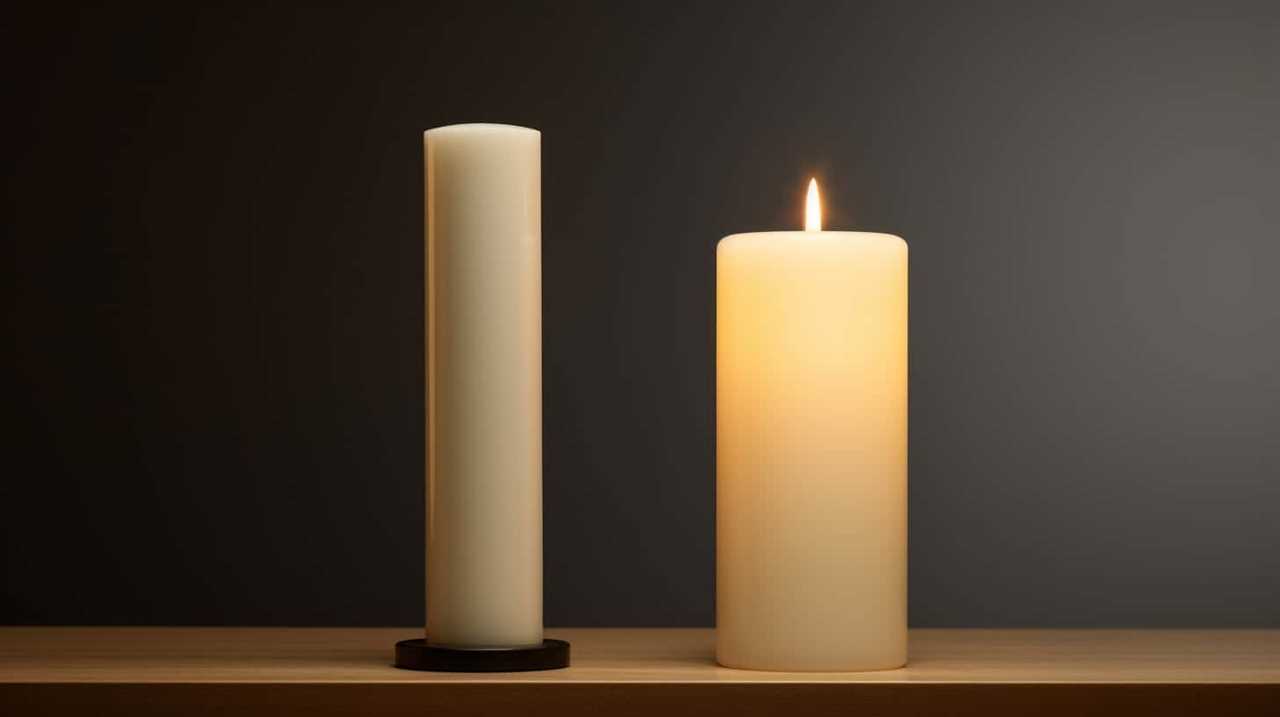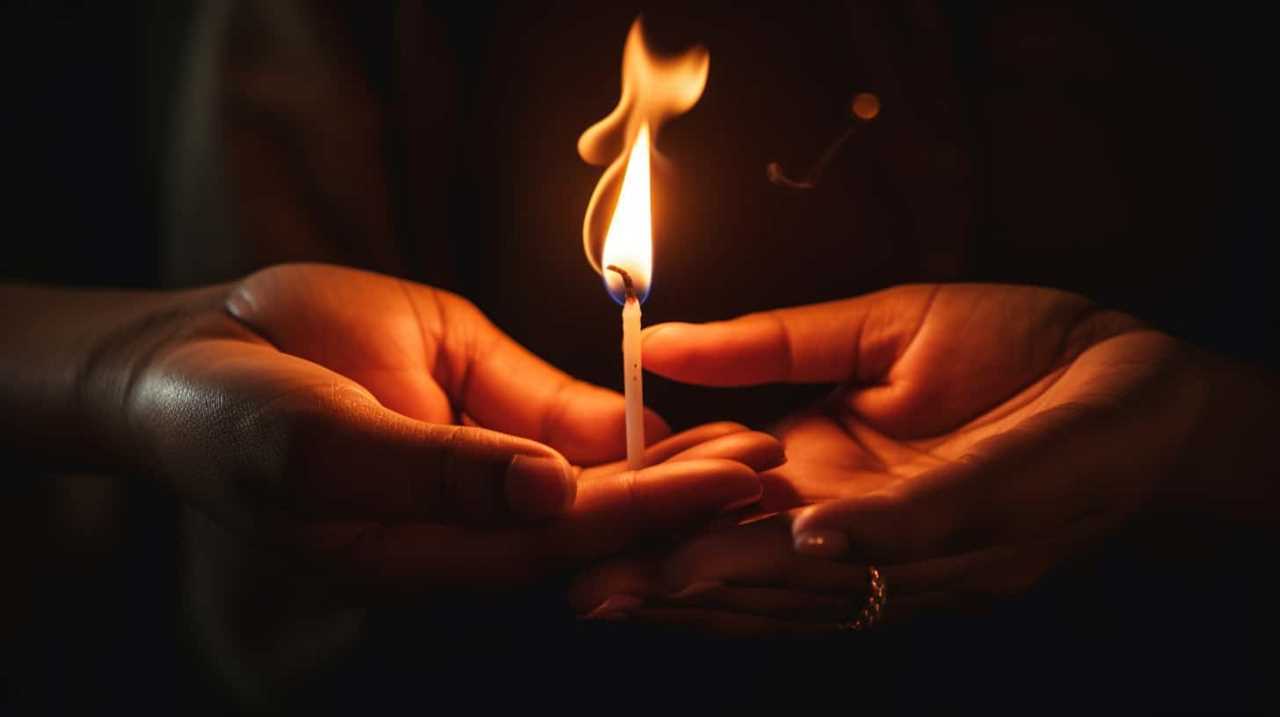When a candle’s flickering light moves and changes, it suggests that there is more happening than what is immediately visible. Just as a gentle breeze can cause a candle’s flame to sway, our lives are intertwined with subtle cues and underlying meanings.
In our journey to understand the world around us, we’ve discovered that candle flickering holds a deeper significance. Through history, culture, and spirituality, we’ve unraveled the mysteries behind this mesmerizing phenomenon.
From superstitions and beliefs to the science that underlies it all, we’ve explored every aspect to shed light on the meaning behind a flickering candle. Join us as we delve into the secrets and symbolism of candle flames, uncovering the profound messages they carry.
Key Takeaways
- Candle flickering has historical and cultural significance, often associated with spiritual presence or communication from the divine.
- The flickering of a candle holds symbolic meanings such as life, energy, and the eternal cycle of birth and death.
- Interpretations of candle flickering vary across different cultures, with some believing it is a communication from the spiritual realm or a departed loved one.
- Candles are recognized as powerful metaphors for spiritual enlightenment and illumination, representing the inner light within each individual.
Historical Significance of Flickering Candles
When a candle flickers, it signifies something significant in our history. The historical origins of candle flickering can be traced back to ancient times, where candles were used as a primary source of light. In those times, people believed that the flickering flame was a sign of spiritual presence or communication from the divine. This belief was reinforced by the fact that candles were often lit during religious ceremonies and rituals.

From a psychological perspective, the flickering flame of a candle has been interpreted as a symbol of uncertainty and instability. It can evoke feelings of vulnerability and unease, reminding us of the impermanence of life.
With this understanding, we can now transition into the subsequent section about the cultural interpretations of candle flickering.
Cultural Interpretations of Candle Flickering
As we explore the cultural interpretations of candle flickering, we aim to understand the symbolic meanings behind this phenomenon.
Across various cultures, the flickering of a candle holds significant significance and is often associated with spiritual or supernatural elements. These interpretations vary from culture to culture, shedding light on the diverse ways in which people perceive and interpret the natural behavior of a flickering flame.

Symbolic Meanings of Flickering
Although cultural interpretations may vary, the flickering of a candle holds symbolic meanings that are deeply rooted in different societies around the world.
The historical origins of these interpretations can be traced back to ancient times when candles were used for religious ceremonies, rituals, and celebrations.
In many cultures, the flickering of a candle is seen as a symbol of spiritual presence or divine intervention. The rhythmic dance of the flame is often associated with life, energy, and the eternal cycle of birth and death.
In some traditions, a flickering candle is believed to be a sign of communication with the spirit world or a message from the divine. It’s also considered a symbolic gesture of hope, guidance, and protection.

The flickering flame can be seen as a metaphor for the human soul, constantly striving and seeking enlightenment.
Cross-Cultural Interpretations Explained
We will now delve into the cross-cultural interpretations and explanations of candle flickering, shedding light on the various cultural perspectives surrounding this phenomenon.
The historical origins of candle flickering interpretations can be traced back to ancient civilizations, where it was believed to be a communication from the spiritual realm. In some cultures, a flickering candle is seen as a sign of a departed loved one trying to communicate with the living. Other cultural interpretations suggest that a flickering candle represents the presence of a guardian spirit or a divine presence.
From a psychological standpoint, some believe that the flickering of a candle can be attributed to air currents or changes in temperature. These interpretations highlight the rich diversity of beliefs and traditions across different cultures.

As we transition into the next section about symbolism in spiritual practices, we’ll explore how candle flickering is deeply intertwined with spiritual rituals and ceremonies.
Symbolism in Spiritual Practices
Symbolism in spiritual practices encompasses the use of various objects and actions to represent deeper meanings.
One such object is the candle, which has long been recognized as a powerful metaphor for spiritual enlightenment and illumination.
The flickering of a candle flame holds significant spiritual significance, often believed to symbolize the presence of divine energy or the communication between the physical and spiritual realms.

Moreover, the interpretation of candle flickering can vary across different cultures, each attributing their own unique meanings to this phenomenon.
Candle as Metaphor
In our spiritual practices, candles serve as a powerful metaphor, embodying the essence of light and illumination. Candles have a long history and their use can be traced back to ancient civilizations such as the Egyptians and Romans. They’ve been used in religious ceremonies, rituals, and meditation practices, symbolizing the presence of the divine and the awakening of spiritual consciousness.
From a psychological perspective, candles can represent the inner light within each individual. The act of lighting a candle can be seen as a symbolic gesture of igniting the spark of enlightenment and self-discovery. The flickering flame of a candle can also be interpreted as the fluctuations of the mind, representing the constant movement of thoughts and emotions.
This brings us to the spiritual significance of flickering, which will be discussed in the subsequent section.

Spiritual Significance of Flickering
Continuing our exploration of candles as a metaphor, let’s delve into the spiritual significance of flickering and its symbolism in our spiritual practices.
Candles have long been used as a tool for meditation, prayer, and other spiritual practices. The flickering flame represents the presence of the divine and the connection between the physical and spiritual realms.
In spiritual practices, the flickering of a candle can hold hidden messages and provide guidance. The intensity of the flickering can indicate the strength of one’s spiritual energy or the presence of spiritual beings. A steady, consistent flame suggests stability and balance, while a flickering flame may suggest the need for inner reflection or the presence of spiritual transformation.
Interpretations in Different Cultures
As we delve deeper into the spiritual significance of flickering candles, it is important to explore the interpretations of this symbolism in various cultures and their respective spiritual practices. The historical origins of candle symbolism can be traced back to ancient civilizations such as the Egyptians and the Romans, who believed that candles had the power to connect the earthly realm with the divine. In different cultures, candles are used in a variety of rituals and ceremonies to invoke spiritual energy, bring blessings, and ward off negative forces. Let’s take a closer look at some cultural interpretations of flickering candles:

| Culture | Interpretation |
|---|---|
| Hinduism | A flickering candle symbolizes the presence of deities or divine energy. |
| Buddhism | A flickering candle represents the impermanence of life and the transient nature of existence. |
| Christianity | A flickering candle signifies the presence of the Holy Spirit and divine guidance. |
| Native American | A flickering candle is believed to attract spirits and facilitate communication with the spiritual realm. |
These interpretations highlight the rich diversity of cultural rituals and their unique perspectives on the symbolism of flickering candles.
Superstitions and Beliefs Around Flickering Candles
We often associate flickering candles with various superstitions and beliefs. These beliefs have historical origins, dating back to ancient times when candles were used for religious ceremonies and rituals.
One common superstition is that a flickering candle symbolizes the presence of a spirit or ghost. However, this belief has been debunked by scientific explanations. The flickering of a candle flame is primarily caused by air currents in the surrounding environment. When there’s a draft or movement of air, it disrupts the flow of oxygen to the flame, causing it to flicker.
Additionally, the wax and wick of the candle can also affect the stability of the flame, leading to flickering. Therefore, while flickering candles may hold symbolic meaning in some cultures and traditions, it’s important to understand the scientific reasons behind it and not attribute it solely to supernatural forces.

Hidden Messages in Candle Flames
Candle flames can convey hidden messages through their behavior and characteristics. Interpreting symbolism from candle flames requires careful observation and understanding of their various traits. Here are three sub-lists that delve into the deeper meanings that can be derived from candle flames:
- Flame Height:
- A tall flame may indicate success, progress, or positive energy.
- A low flame could suggest a need for protection, caution, or introspection.
- An inconsistent flame height may signify uncertain or unstable circumstances.
- Flame Color:
- A blue flame may symbolize tranquility, healing, or spiritual energy.
- A yellow flame often represents intellectual stimulation, creativity, or communication.
- A red flame can signify passion, courage, or intense emotions.
- Flame Movement:
- A steady flame suggests stability, focus, or a balanced state.
- A flickering or dancing flame may imply change, excitement, or the presence of spirits.
- A turbulent or erratic flame could indicate conflict, uncertainty, or a need for resolution.
Through careful observation and interpretation, hidden messages can be deciphered from the behavior and characteristics of candle flames, offering insights into various aspects of life.
Exploring the Science Behind Candle Flickering
Understanding the reasons behind candle flickering requires an examination of the scientific principles at play.
Candle flickering has long fascinated humans, with its mesmerizing dance of light and shadow. Scientific studies have delved into the underlying mechanisms behind this phenomenon.

It’s known that the flickering of a candle flame is caused by the interaction between the heat of the flame and the surrounding air currents. These air currents, also known as convection, create variations in the temperature and density of the air, leading to the characteristic flickering motion.
Additionally, psychological effects such as the perception of warmth and comfort associated with candlelight can also influence the flickering pattern.
Candle Flickering as a Sign From the Universe
As we delve deeper into the mesmerizing dance of candle flickering, it becomes intriguing to consider the possibility of it being a sign from the universe. While it’s easy to dismiss candle flickering as a mere result of air currents and temperature fluctuations, many believe that there’s a deeper meaning behind this natural phenomenon.
Here are three sub-lists that explore the potential significance of candle flickering as a sign from the divine:

- Candle Flickering Rituals:
- In various cultures and spiritual practices, candle flickering is often incorporated into rituals as a means of communicating with the divine.
- People light candles and observe their flickering patterns to seek guidance, protection, or to send intentions out into the universe.
- The specific way a candle flickers is believed to hold symbolic messages depending on the direction, intensity, and duration of the flickering.
- Signs from the Divine:
- Many individuals interpret candle flickering as a form of communication from a higher power or the universe.
- It’s believed that the flickering can indicate the presence of spiritual beings or the alignment of energies.
- Those who believe in signs from the divine often seek meaning in the flickering patterns and associate them with specific messages or guidance.
- Personal Interpretation:
- The interpretation of candle flickering as a sign from the universe is subjective and personal.
- Individuals often rely on their intuition and spiritual beliefs to decipher the meaning behind the flickering patterns.
- It’s important to approach these interpretations with an open mind and to trust one’s own inner guidance when seeking meaning in candle flickering.
While science may provide explanations for the physical causes of candle flickering, the belief in its potential as a sign from the universe remains a deeply personal and spiritual matter.
Interpreting Candle Flickers in Different Settings
Let’s explore how we can interpret candle flickers in various settings.
The practice of interpreting candle flickers has its historical origins in ancient cultures, where it was believed to be a form of communication from the spiritual realm. However, in modern times, scientific explanations provide a more rational understanding of this phenomenon.
Candle flickering can be influenced by factors such as air movement, temperature changes, and the quality of the candle itself. For example, a drafty room may cause a candle to flicker more vigorously, while a still environment may result in a steady flame.

By observing the specific characteristics of the flicker, such as its intensity, duration, and pattern, we can gain insights into the environment and conditions surrounding us.
Understanding these interpretations sets the stage for harnessing the power of flickering candles for manifestation.
Harnessing the Power of Flickering Candles for Manifestation
To harness the power of flickering candles for manifestation, we can carefully observe their unique characteristics and utilize them as tools for manifestation. By understanding the science behind the flickering flame, we can tap into its energy and channel it towards our desires.
Here are three manifestation techniques using flickering candles:

- Intention Setting: Before lighting the candle, clearly state your intention for manifestation. Focus on your desires and visualize them coming to life. As the candle flickers, imagine the energy of your intention being released into the universe.
- Affirmations: Write down positive affirmations that align with your desires. As you light the candle, repeat these affirmations with conviction. Watch the flame flicker and imagine it amplifying the power of your affirmations, sending them out into the world.
- Meditation: Sit in front of the flickering candle and enter a meditative state. Focus on your desires and let go of any doubts or negative thoughts. Allow the energy of the candle’s flickering flame to guide you towards manifestation.
Frequently Asked Questions
How Can I Interpret the Flickering of a Candle in a Religious Ceremony?
When interpreting symbolism and spiritual significance of a candle flickering in a religious ceremony, we observe its movements and intensity. It can symbolize divine presence, communication, or even indicate the presence of spirits.
Are There Any Specific Superstitions or Beliefs Associated With a Candle Flickering During a Thunderstorm?
Superstitions and beliefs often surround the flickering of a candle during a thunderstorm. Some interpret it as a sign of supernatural presence, while others see it as a warning of impending danger.
What Are Some Common Hidden Messages That Can Be Found in Different Types of Candle Flames?
Hidden messages in candle flames can reveal symbolism and meaning. The flickering of candles can signify spiritual presence or energy fluctuations. By observing the flame’s color, shape, and movement, one can uncover profound insights into the unseen world.
Can the Science Behind Candle Flickering Be Used to Predict Future Events or Outcomes?
The flickering of a candle holds no predictive power or scientific explanations. It is simply a natural phenomenon caused by air currents. The candle’s dance is mesmerizing, but it reveals no secrets.

How Can I Use the Power of Flickering Candles to Manifest My Desires and Intentions?
Using flickering candles for manifestation involves understanding the symbolism of candle flickering. By observing the patterns and intensity of the flicker, we can align our intentions and desires with the energy emitted, enhancing the power of manifestation.
Conclusion
In conclusion, the flickering of a candle holds a rich tapestry of historical, cultural, and spiritual significance. It symbolizes hidden messages, superstitions, and even acts as a sign from the universe.
Exploring the science behind candle flickering unveils the intricate dance of heat, air currents, and wax composition.
Whether in a sacred ritual or a cozy living room, the flickering flame captivates our senses and holds the power to manifest our deepest desires.

Embrace the power of the flickering candle and let its rhythmic dance guide you on your journey.
















